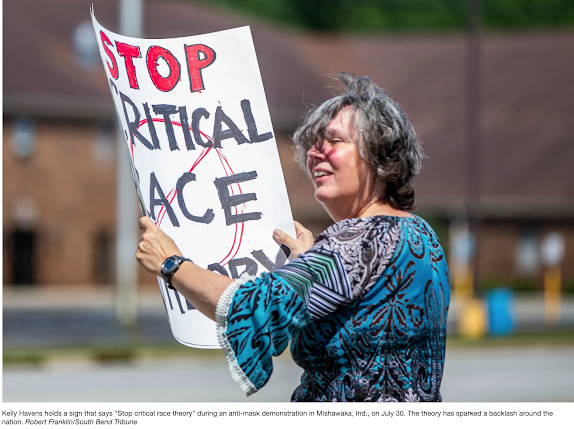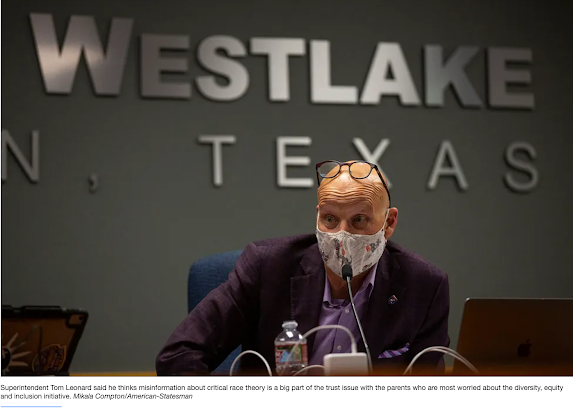By Sarah Asch | Austin American-Statesman, Aug. 24, 2021
"Critical race theory" has become a catch-all term for anything related to race or equity over the past year, with nearly identical arguments about it playing out in state legislatures and school board meetings across the country.
This includes the Eanes school district, in a small, majority white, largely affluent community west of Austin, where parents have vocalized their fears about critical race theory. Many conflate the theory with the district’s diversity, equity and inclusion initiative and worry that white children will be taught to feel guilty and that an unwanted political agenda will be forced on kids in the classroom.
Eanes school board members and administrators have been quick to say this is not what critical race theory does and that the theory is not being used in their schools or as part of the DEI initiative, but many in the community do not believe them. Often lost in this back and forth is an understanding of what critical race theory is and how it came to be a buzzword in the pushback against equity efforts in education.
What is critical race theory? Experts explain
Jennifer Keys Adair, an associate professor of curriculum and instruction at the University of Texas, said that sometimes it is easier to start with what critical race theory is not.
“Critical race theory is not a curriculum. It's not even an idea. Critical race theory is like a pair of glasses that you put on to try to understand ongoing racial injustice. That's all,” she said. “It's a very high-level, sophisticated set of readings and lenses to look at the law and to look at the way that we set up systems.”
Critical race theory was developed in law schools more than 40 years ago as a way to understand how racism continues to exist even after legal racial segregation ended in the 1960s and 1970s, according to Keffrelyn Brown, who teaches cultural studies and education at UT.
Brown said critical race theory has spread from the legal academy to other fields, including the study of education. It is primarily used at the graduate school level and sometimes at the college level.
“Critical race theory is not a catch-all for all diversity, equity and inclusion initiatives or programs,” she said. “It is not a tool that is being used to make any particular person or group feel guilty, and it’s not something that historically is taught in K-12 schools.”
Rather than emphasizing individual actions, experts say critical race theory focuses on how systems and structures reproduce racist outcomes.
“When you talk about critical race theory, or any theory about structural racism, it’s really much less about people,” said Wendy Leo Moore, an associate professor of sociology at Texas A&M University. “It doesn’t have anything to do with people being bad. It has to do with structures that are in place. ... The words ‘critical race theory’ are being deployed to mean ‘whatever is going on that might be related to race that I don’t like.’ I think that most people don’t have any idea what critical race theory actually is.”
Brown said the distinction between critical race theory and unrelated equity work, such as the Eanes DEI initiative, is important because when the two become conflated it distracts from the underlying goal of making schools better places for students of color to learn.
“The clumping together of all DEI concerns and initiatives into critical race theory is dangerous and problematic,” she said. “When we demonize CRT, we don’t put anything in its place to understand racism or account for racism. ... We have to continue to do this work; we cannot allow these conversations to derail.”
Critical race theory on a national scale
The use of the phrase "critical race theory" as a catch-all term in recent months is often traced back to an executive order signed in September by then-President Donald Trump that directed all federal agencies to stop anti-bias training that relied on critical race theory or discussed white privilege. The memo called such training sessions “anti-American propaganda.”
Since then, some conservative parents and media figures have lodged increasing protests against diversity initiatives that they say represent critical race theory encroaching on public education.
Governors in six Republican-led states signed legislation this year to limit how issues of race can be taught in the classroom. Gov. Greg Abbott signed such a bill into law in June — it is often referred to as the “critical race theory bill,” although it does not mention the theory by name. The bill bars Texas public grade-school teachers from awarding students course credit for social or political advocacy work and prevents schools from requiring teachers to discuss particular current events.
Debate about critical race theory is so widespread that the Texas Association of School Boards published a flyer on June 25 to help school board members explain the difference between new or ongoing district initiatives and critical race theory. The flyer states that critical race theory is not part of the social studies curriculum in Texas, but that working toward equitable outcomes for all students has long been part of state and national education policy.
Concerns beyond critical race theory
Parents in Eanes who draw the connection between the and their understanding of critical race theory point to the district’s consultant, Mark Gooden, and his use of the theory in his academic work as evidence that it is influencing Eanes. Gooden’s use of the theory in his writings taints the initiative for a lot of people, many of whom do not trust that district leaders are telling the truth when they say critical race theory is not being used.
“If DEI is teaching the Golden Rule, that’s great. The problem is that our consultant is a critical race theory expert,” parent Jennifer Stevens wrote in an email to the Statesman. “His own book and presentations are based in CRT. ... CRT is racist. It teaches our children to judge others based on the color of their skin. That is wrong.”
Christie Oates, another parent in the district, said she does not trust the district’s intentions when it comes to Gooden. She said Gooden’s expertise speaks for itself.
The DEI initiative "is a political agenda, and it’s nothing more than a solution to a problem that doesn’t exist, and has done nothing but create problems and create tension and create a divide and waste the community’s money. ... It’s an excuse to bring in CRT, or CRT components,” she said. “If it walks like a duck and quacks like a duck, then that’s what we’re doing.”
Whether parents in Eanes call the initiative critical race theory or not, many have worries about it that go beyond how an academic theory is defined. In conversations about the initiative, parents have voiced their fear that talking about race through the lens of historical racism is akin to indoctrination and that it unnecessarily highlights racial differences.
“What we are doing now is indoctrinating children into a mindset that is a belief and not a fact,” parent Marc Pearl said. “My political beliefs should be taught to my child in my household.”
Pearl said he would like to see the school address individual instances of racism, but he does not want systemic racism to be taught as a fact but rather as one belief among many. He worries that the initiative will lead to the district teaching children that white people are oppressors and that people of color are oppressed. Pearl pulled his son out of the district during the pandemic and sent him to a private school, and he said he does not plan to return unless his issues with the initiative are addressed.
“We were raised in a colorblind society, and now we’re flipping that on its head, and we have to be absolutely aware of all races,” he said. “We are well past the 1960s civil rights movement. We have achieved greatness from the horrible sins in the past. There is no need for this. This is just division.”
Gooden said he does not think the definition of critical race theory is the root of the discord in Eanes, although he said his work with the district cannot be described as critical race theory.
“What we are doing, and I think this is what people are feeling the most anxious about, is we're having conversations about race and racism. We're talking about how those two concepts have been really intertwined in the development of America and how they are currently with us today and still have an impact,” he said. “For a lot of people, this pushes against what they understand to be an American ideal that everybody has an equal chance.”
Many scholars in history and education think that incorporating conversations about racism into public schools will help students better understand the world around them.
Monica Martinez, a history professor at UT, said she sees recent efforts to include conversations about race and racism as part of a long push by communities of color for curricula and campus cultures that take their experiences into account.
“We have to have truthful conversations about the history of slavery, and the history of colonization and conquest, that intersect in Texas in really important ways,” she said. “You have to teach about race; you have to talk about gender; you have to talk about religion; you have to talk about issues like immigration. ... These topics shouldn't be seen as controversial; it's just teaching the truth.”
 Martinez worries that disinformation is taking over the discussion about the role public schools have in educating informed citizens.
Martinez worries that disinformation is taking over the discussion about the role public schools have in educating informed citizens.
“There is so much misinformation about things like critical race theory. So many of the sponsors of these bills are really raising fear,” she said. “It's unfortunate because I think, at its worst, it can dissolve public trust in public schools, which are such a vital and important public institution.”
At the local level in Eanes, Superintendent Tom Leonard said the debate about critical race theory is where he sees the conversation about diversity, equity and inclusion veer toward national politics and away from what is playing out on the ground.
Discussions about critical race theory tend to focus on what the district plans to teach in the classroom, but the DEI initiative has focused on training staff members to tackle the conversations and incidents that already are happening in schools, he said.
Leonard said he thinks misinformation about critical race theory is a big part of the trust issue the district has with the parents who are most worried about the initiative.
“Our version of what we wanted to do with DEI, which truly was to make everybody feel welcome and safe and respected and all that, I didn't see that as being something that people would have a problem with. ... Somewhere along the line, some people took a focus with CRT. ... And no matter what we have said, that group has not yet believed us," he said. “I believe we are telling the truth. And I think it's unfortunate that this has become a national political debate.”
 Martinez worries that disinformation is taking over the discussion about the role public schools have in educating informed citizens.
Martinez worries that disinformation is taking over the discussion about the role public schools have in educating informed citizens.







No comments:
Post a Comment